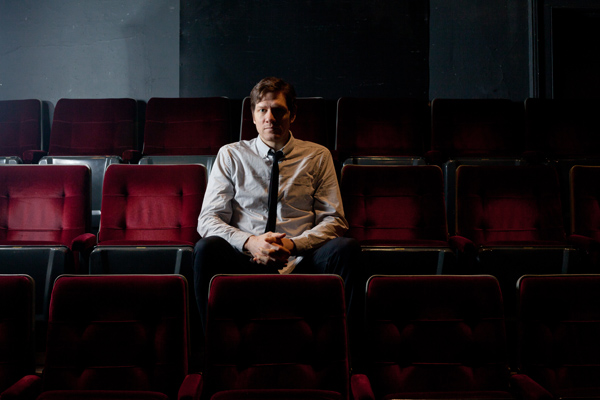
Adam Rapp. Photo by Kristianna Smith
There’s this part of the process of making theater that is really hard to articulate. I’ve been in Louisville, Kentucky, directing a new play for the Humana Festival, but had to return to New York for a few days this past weekend and had a chance to check in on my Hallway Trilogy at Rattlestick, which I and many others have been working on since mid-December. Returning to see two of the three plays was one of the loneliest experiences I’ve had in the theater. The plays were in great shape – even better than when I left, as the actors are still finding nuance and digging deeper into their roles. I was proud and relieved that the work hadn’t drifted, but rather that it had gotten sharper. But one thing was clear: the company of fourteen actors, three stage managers, the box office manager and the small staff didn’t need me anymore. The ship had sailed and I was, well, somewhere else. At the risk of sounding whiny or just plain sentimental, for any playwright or director who is willing to admit it, this dislocating sadness is a familiar feeling after a show opens, but it was particularly intense this time, perhaps made worse by the fact that there wasn’t a seat for me in the audience (not a bad problem to have), so I couldn’t ally myself with that group either. I wound up watching from extreme house right, in the little waiting area near the box office, and much of the stage-left action was lost to me.
You hear stories of playwrights pacing under the risers or mysteriously lurking in the shadows during the run of a play. It’s ghostly imagery, as if we’re literally haunting the theater, or caught in some netherworld between the actors, the audience, and the box office. In short, we are no longer needed and there is some pain involved with this. It is a kind of bittersweet damnation. On Saturday, after I saw Rose and Paraffin I hugged the actors and told them I missed them and we all said encouraging things to each other. A few of us even went to the corner café and got a bite to eat, but I couldn’t shake the haunted feeling that the proverbial ship had sailed and I was no longer on it.
It has been said that theater is an ephemeral art form. It is not a document or an artifact or a piece of celluloid. It can’t be hung on a wall or permanently installed on a campus lawn. If anything it is a live dream that becomes an instant memory once the audience exits the space. It is a witnessing, an illusory gasoline cloud, a brief mountain fog. When done right it’s a kind of narrative spell that has its own planetary laws, its own little weather system. The run of a show often only lasts a month after opening, sometimes less. Naturally, there are ups and downs with this: friendships are forged, sometimes lasting, sometimes not; lovers find each other (and sometimes wind up hating each other); occasionally there is a dressing room fistfight; there is often a member of the crew who is either injured or exasperatedly quits. Things can get as hairy as they are exhilarating.
During the first week of previews, our costume designer, Jessica Pabst, was in the dressing room during part one, Rose, and she accidentally triggered a machine that contains the fake blood for the run of the show. The entire dressing room, floor-to-ceiling, was awash in a tsunami of stage blood. Miraculously, very few costumes were ruined, but the sight was grisly, something out of a Tarantino film. The fact that it took place at approximately minute twenty-three of the play made it even more of a miracle in that it wasn’t seen or in any way experienced by the audience. Logan Marshall-Green, an actor in the company, took digital photos. Horror movies aren’t designed as beautifully. These are the kinds of things that happen during the run of a play. They elevate it from the anecdotal. Though it’s simple math, every performance is one less in the short life of a play and as I do more of these, more and more I appreciate the brutal mortality quotient involved. And I mourn their openings harder and harder.
On January 3rd, fourteen actors, three directors, a handful of designers, a small SWAT team of stage managers and production assistants, the press agent, the small staff of Rattlestick led by Artistic Director David Van Asselt, and a few others gathered to read all three plays, in sequence, in a six hour affair that would launch this rare and beloved project. There was a collective feeling of excitement in the room, as well as trepidation, anticipatory despair, and adolescent giddiness. There was also an inordinate amount of coffee and donuts consumed, which happened so fast it was as if we all knew we were about to be starved for an experiment.
As I write this, I marvel that we were able to pull it off, and that for the most part, the entire company entered this crazy forest with child-like fascination. You make these little families in the theater, and then you say goodbye to them forever. Is it sentimental? Perhaps a bit, but aside from a few people, I’ll take this over my own flesh-and-blood any day of the week. This thing of making a live dream happen can be pretty intoxicating, even when one fails at it. The Hallway Trilogy has been particularly hard to let go of. So call this my little awkward elegy.
Louisville, KY.
]]>